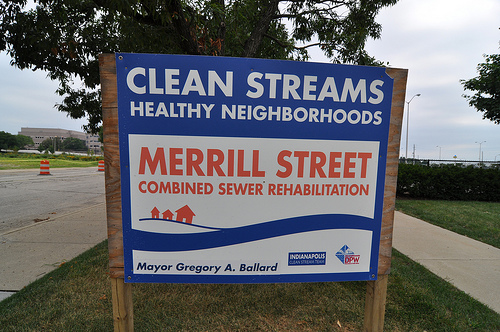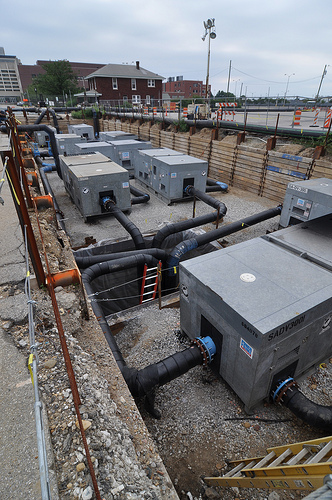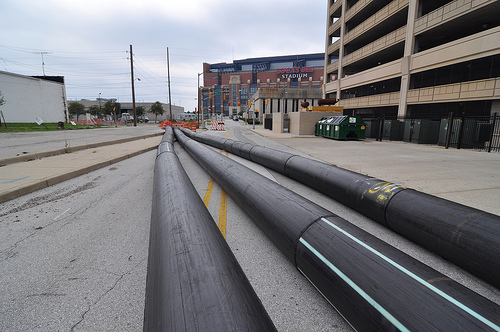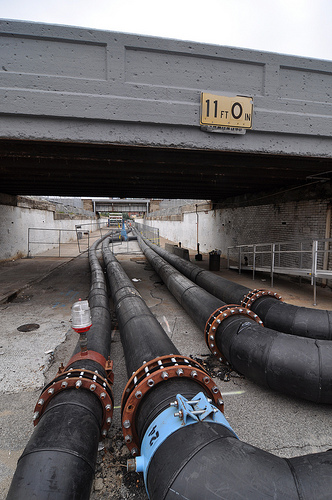
If you spend any amount of time on the south side of downtown Indianapolis you may have noticed a large scale project going on. It looks to the casual observer like a bunch of pipes that are suppose to be under the ground, that are routed above ground for the most part along city streets and occasionally buried beneath at street crossings using thick steel plates.

This past weekend, I started at the Lilly campus where the pipes appear to begin and started walking, armed with my camera. What I discovered, was a vast stretch of pipes traversing the streets of downtown’s less dense areas. Namely, where a lot of parking lots and abandoned streets are located. I discovered a pumping station in the ground, but open to the air. There were many things to check out and as I walked, the scope of the project only got bigger. The shear amount of pipe on the ground indicates a large amount of labor was invested to just get these all hooked together. That tells me that this must be a pretty big, and important, project.

The roots of our focus area here should probably start with the Indiananapolis DPW (Department of Public Works). Navigating their website can be as tricky as making your way through a cornfield maze at halloween time. Their site is divided up into many different sub categories classified by the type of work going on. Luckily, they devote a lot of space to sewer and water issues. A topic which has gotten a lot of press in Indy over the last couple years, and will undoubtedly get MUCH hotter, is that of CSO’s or Combined Sewer Overflows. Back when our fore fathers started platting cities, they thought that it would be convenient to combine sewer drainage, and storm water drainage. Today, we see the very reality of what our fore fathers did, making life difficult for us. The federal government has, in recent years, decreed that all cities with CSOs undertake plans to split these utilities into seperate sewer and overflow drainage systems. The obvious point here, is that less raw sewage will end up in our rivers. Indianapolis’ long term plan can be found here.

With this decree came the realization that MASSIVE work (and expense) would be required to do this. In the future, that will require some serious tax hikes for sewer and water users of Marion County. This has also gotten a lot of press lately albeit a bit more politically focused, in the form of Mayor Greg Ballard’s attempt to “sell” the sewer and water utilities to Citizen’s Energy. They claim that future rate increases will be less than they would be under the current operating conditions. That obviously, remains to be seen.
What is going on right now on the southside of downtown, appears to be a comparatively minor piece of the overall picture though. Through the DPW’s website, I was able to view the list of projects from 2009-2013. If you focus on the areas designated by CS-32-005 you will get a sense of the area of focus for this article.

According to the sign on site, this is the Merrill Street Combined SewerRehabilitation portion. According to informal requests to the DPW, they are calling this a sanitary sewer bypass. Upon further sleuthing, I was able to find that this involves “in place curing of pipe liner and manhole rehabilitation”. Also, the work should be finished up by late August to mid-September according to the same inquiry. When this project is complete, expect a much more visually appealing project begin to take shape. UrbanIndy.com will have some information on that in the near future; but for now, take comfort in the fact that the work that is taking place now while ugly in appearance, is being done to make our enviroment a little better for us now, and a LOT better for our children.
Thanks for this! Was curious what was going on around there.
Another aspect of this enormous challenge (eliminating CSO’s) is the role that green infrastructure plays. Every rain garden, every slab replaced with pavers or porous concrete, and every downspout disconnected from our stormwater system helps reduce sewage flowing into our waterways.
Curt’s previous entries on the rain gardens at the Athenaeum and the Cultural Trail show that it is easy to incorporate green infrastructure in Indianapolis, and it looks good too. What could be better than having native plants and wetlands throughout the city while our streams continue to improve in quality and cleanliness?